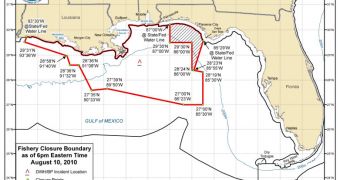More than 5,144 square miles of water from the Gulf of Mexico have been opened for fishing. The area was part of the region affected by the BP/Deepwater Horizon oil spill, but now officials at the US National Oceanic and Atmospheric Administration say that fish here is safe to eat.
The decision to allow commercial and leisure fishing in this area was taken after NOAA representatives discussed the issue with colleagues from the US Food and Drug Administration (FDA). The two agencies also validated the decision by signing a new protocol with all so-called Gulf states.
“Consumer safety is NOAA’s primary concern, which is why we developed rigorous safety standards in conjunction with the FDA and the Gulf states to ensure that seafood is safe in the reopened area,” explains NOAA Administrator Jane Lubchenco, PhD.
“We are confident that Gulf fish from this area is safe to eat and pleased that recreational and commercial fisherman can fish these waters again.” says Lubchenco, who is also the US under secretary of commerce for oceans and atmosphere.
According to the readings federal agencies have, no oil has been identified in the recently-opened fishing area since July 3. Reconnaissance missions flown by the United States Coast Guard (USCG) over the region also failed to identify any discernible signs of oil contamination.
Computer simulations that model the path the existing Gulf oil will take in the new future shows that the region will not be affected as well. Additionally, fish samples taken from these waters have shown that the marine life here exhibits no signs of contamination.
NOAA scientists looked at finfish including grouper, snapper, tuna and mahi mahi, and determined that these species posed no health risk for the general population. Between June 27 and July 20, the study team looked at more then 153 samples, and found the results to be consistent overall.
“We know how important it is to the culture and economy of this region to get back out on the water and be able to once again harvest the seafood that the Gulf is famous for,” explains the commissioner of food and drugs, Dr. Margaret A. Hamburg.
“But our top priority in the wake of this disaster must be the safety of the fish that makes it to market. We are confident that the proper processes have been followed, and that consumers can feel good once again serving their families seafood from these waters,” she adds.
“The closed area now covers 52,395 miles, or 22 percent of the federal waters in the Gulf, down from 37 percent at its height. On July 22, NOAA reopened 26,388 square miles of Gulf waters off of the Florida Peninsula,” NOAA officials conclude in a press release.

 14 DAY TRIAL //
14 DAY TRIAL //